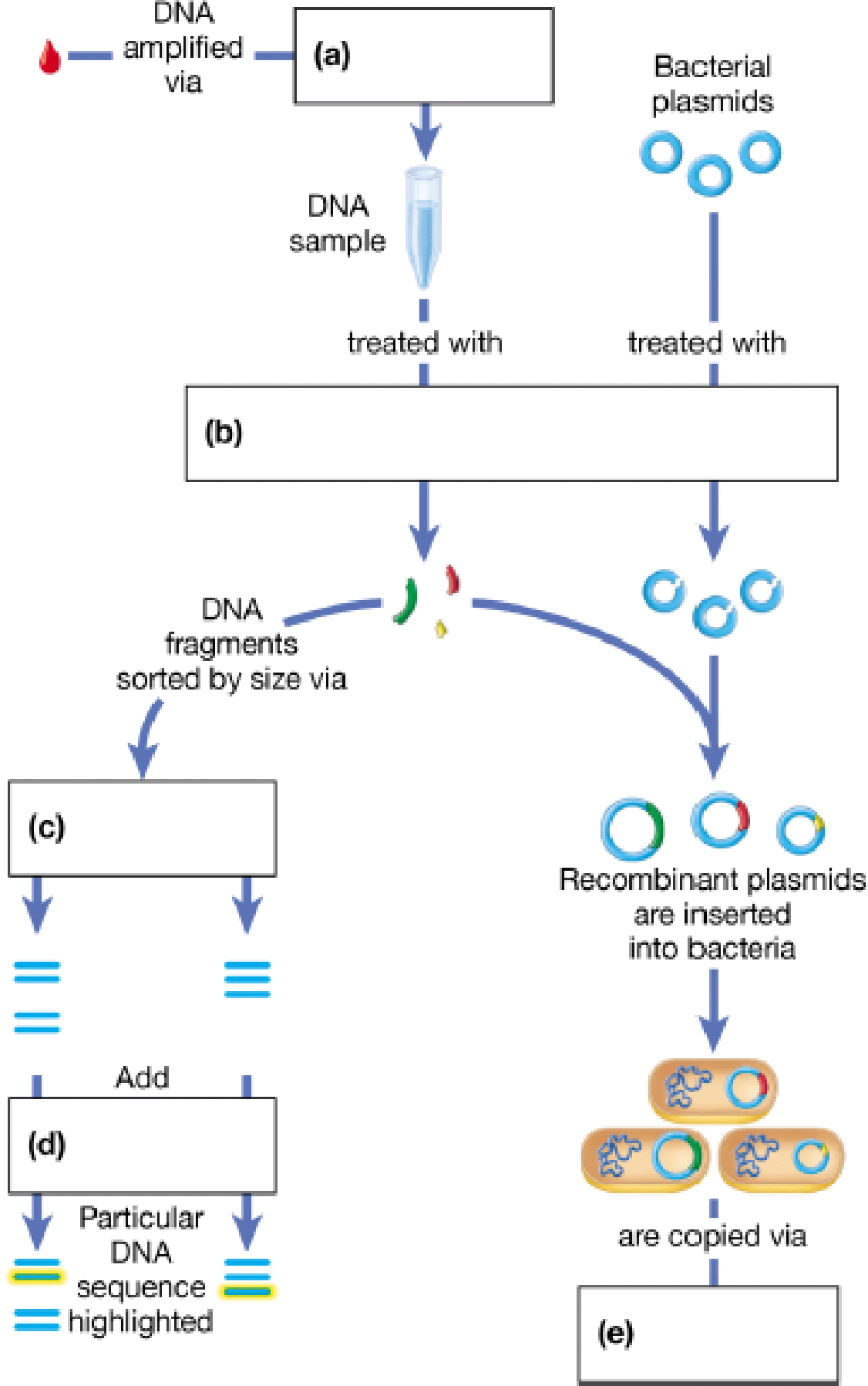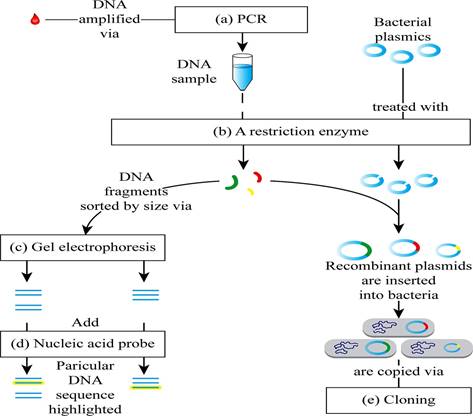
Concept explainers
Imagine you have found a small quantity of DNA. Fill in the following diagram, which outlines a series of DNA technology experiments you could perform to study this DNA.

To complete: The given map showing the steps involved in recombinant DNA (rDNA) technology.
Introduction: Recombinant DNA technology is a technique used to produce novel genetic combinations by combining the genes from two different organisms and introduces them inside a host in order to proliferate and grow.
Answer to Problem 1CC
Pictorial representation: Fig. 1 shows the completed map of the steps involved in recombinant DNA technology.

Fig. 1 The steps involved in recombinant DNA (rDNA) technology.
Explanation of Solution
(a)
Correct answer: PCR
Explanation: The polymerase chain reaction (PCR) is used to get multiple copies of DNA within a short period. In PCR, for synthesizing multiple copies of a specific DNA fragment, DNA nucleotide primers are used. Hence, the correct answer is PCR.
(b)
Correct answer: A restriction enzyme
Explanation: Restriction enzymes are a group of enzymes used to cut the DNA by binding to certain specific DNA sequence sites called as restriction sites. It forms single-stranded ends called as sticky ends. The sticky ends help the DNA to bind with the other DNA fragment that has the same single-stranded ends by complementary base pairing. Hence, the correct answer is a restriction enzyme.
(c)
Correct answer: Gel electrophoresis
Explanation: Electrophoresis is used to separate the molecules based on their size and charge in the presence of an electric field. Hence, the correct answer is Gel electrophoresis.
(d)
Correct answer: Nucleic acid probe
Explanation: Nucleic acid probe is used for the analysis of the probe, which can specifically bind to the complementary DNA strand. Hence, the correct answer is nucleic acid probe.
(e)
Correct answer: Cloning
Explanation: The process of production of identical copies of the parent cell is called as cloning. Cloning vectors are used in the rDNA technology for the propagation of the desired gene. Hence, the correct answer is cloning.
Want to see more full solutions like this?
Chapter 12 Solutions
CAMPBEL BIOLOGY:CONCEPTS & CONNECTIONS
- The following image is of an agarose gel. If DNA samples were loaded to this gel and the electrophoresis experiment was started, explain what would happen and why.arrow_forwardAll of the following are examples of materials that are bound by your purifying medium during the DNA extraction process, except: O endoplasmic reticulum extraneous DNA O Calcium (Ca2+) O Iron (Fe2+) O Magnesium (Mg2+) O lipid membranesarrow_forwardExamine the sequence for the DNA fragment below. Your job is to design primers for PCR that would be able to amplify this entire DNA fragment. Your answer must fulfill the following criteria: Design the primers so that they are each 7 bases in length. Please write out the sequence of these primers. Don’t forget to indicate the direction (polarity) of both ends of each primer. Note that only the polarity of one end of one of the template strands of DNA is provided below. Describe where the primer would bind (i.e. top or bottom template strand, left or right side of the DNA strand) Organize your response so that each primer, and associated information, is separated by at least one blank linearrow_forward
- Examine the DNA fragment sequence below. Your job is to design primers for PCR that would be able to amplify this DNA fragment. Design the primers so that they are 7 bases in length. Don’t forget to indicate direction (polarity) of the primers. Also describe where the primer would bind (i.e. top or bottom strand, left or right side of the DNA strand). Please organize your response so that each primer, and associated information, is separated by at least one blank line 5’ - TCCACTTGCTGTGTAGCTAAATCATATAACAG3’ - AGGTGAACGACACATCGATTTAGTATATTGACarrow_forwardWhat types of DNA can be extracted? Explain your answer.arrow_forwardExamine the DNA sequence shown below. You have been tasked with designing Primers for PCR amplification of the whole fragment shown. Your colleague said that she would design one primer and came up with this sequence – 5’ TGCTATC 3’. You, being a good scientist, need to confirm that her work is good. Where will this primer bind on the target DNA? 5’ CGATGCAATCGAGCTATGGCATATCATAAGCGATAGACAGATAGCA 3’ GCTACGTTAGCTCGATACCGTATAGTATTCGCTATCTGTCTATCGT a. This primer cannot be used in the PCR process. b. It will bind to the top strand on the left side of the fragment. c. It will bind to the bottom strand on the left side of the fragment. d. It will bind to the bottom strand on the right side of the fragment. e. It will bind to the top strand on the right side of the fragment.arrow_forward
- Let’s say that you want to find out the difference in nucleotide sequence among two DNA strands, one of which is isolated from the liver of a liver cancer patient and the other one is isolated from the liver of a healthy individual. How you can do that, please explain in detailsarrow_forwardThe diagram (below) shows the completed gel of a Sanger sequencing reaction. The arrows at the bottom point to the well positions where the DNA fragments started, with each nucleotide represented by a single letter abbreviation. Answer the following: • On which end of the image was the positive electrode placed? Type "top", "bottom", "left", or "right". Note that the bottom in this image is the location of the wells. Which well included the smallest DNA fragment at the beginning of the experiment? Type the single letter label for that well (ie, A, T, C, or G). • What is the sequence of the DNA strand synthesized in this Sanger sequencing reaction? Type the sequence starting on the 5' end. 5'- AWA с T G A -3'arrow_forwardFigure 9-22 shows the first steps in the process of making a DNA microarray, or DNA chip, using photolithography. Describe the remaining steps needed to obtain the desired sequences (a different fournucleotide sequence on each of the four spots) shown in the first panel of the figure. After each step, give the resulting nucleotide sequence attached at each spot.arrow_forward
- To be able to properly analyze a sample of DNA, you need to have at least 1 µg of the DNA of interest. Assumptions: PCR is run with 30 cycles; Molecular weight per nucleotide in DNA is about 660 g/bp (330 g/bp for single stranded DNA or RNA); bp = base pair. a. Given that you can use the Polymerase Chain Reaction (PCR) to amplify DNA from the original sample and the size of the fragment to be amplified is 10,000 nucleotides long, estimate how many DNA molecules you need to obtain the minimum amount required to analyze the sample. b. Suggest a way to increase your sensitivity, i.e. amplify the DNA starting from even fewer molecules of template DNA.arrow_forwardGel electrophoresis drives DNA along an electrical current from a negative electrode to a positive electrode. This is because DNA is a negatively charged molecule. Do you think that gel electrophoresis would function differently if DNA was positively charged? How so? Why?arrow_forward2) A scientist wants to increase the amount of sample of a DNA sequence of 100 bps. Calculate the number cycles of PCR required to generate 1 ng of DNA, when starting from a single copy. Note that the molar mass of an average DNA bp is 600 g/mol.arrow_forward
 Human Heredity: Principles and Issues (MindTap Co...BiologyISBN:9781305251052Author:Michael CummingsPublisher:Cengage Learning
Human Heredity: Principles and Issues (MindTap Co...BiologyISBN:9781305251052Author:Michael CummingsPublisher:Cengage Learning
